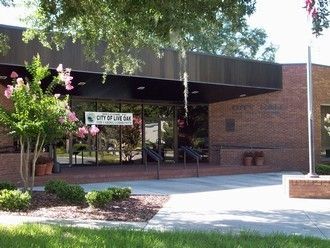City Council workshop roundup
Published 9:00 am Wednesday, April 1, 2015

- City Hall.
The Live Oak City Council met Wednesday, March 25, in a nearly three-hour workshop for discussions involving several water-related issues, expanding or creating a new Community Redevelopment Agency district, and creating safer traffic patterns around the high school. No actions were taken due to the workshop setting.
Adding or expanding a CRA district
The council discussed changing the current CRA district or implementing a second district to encompass more areas in the city in need of development. The CRA board originally brought the idea up during a February workshop.
“The council will have to be proactive in defining the areas that we’re talking about,” advised Councilman and CRA Chairman Keith Mixon. “Keep in mind, with either expansion or a new district, you’ve got to have a good portion of that district commercial. If you just put residential in there, you’re never going to make any money and it’s going to drain the other way. We’ve got to identify those areas that have some commercial development out there.”
Mixon said expanding the district would adversely affect the current district and create a “nightmare” for the finance department.
“We’re much better off to create a new district,” said Mixon. “We can include those areas that were left out and we can include those areas that have slum and blight. We can encompass the commercial districts to make it work.”
In either expansion or addition, it will take time to accumulate funds to spend in the new area. Councilman Jacob Grantham explained the funds from the old CRA district could not be used in new areas included in an expansion; the new areas would have to generate funds before work could be done in them.
Councilmen suggested a separate workshop to examine the CRA district options.
Creating safer school traffic
Live Oak Chief of Police Buddy Williams asked the council to consider installing traffic calming devices such as speed bumps and a crosswalk on Pine Ave. in front of Suwannee High School.
Williams suggested a wide flat-top, also called a speed table, instead of a thinner speed bump. A flat-top could double as a crosswalk, similar to ones used in the Advent Christian Village in Dowling Park. The flat-top can have indentions for emergency vehicles to bypass while still slowing regular vehicles, Williams explained. Williams cautioned that slowing traffic on Pine Ave. would move traffic flow to other streets, although speeds by the high school were cause for greater concern.
“I think we really need to look at the proper device to put down where it’s twofold: crosswalk and traffic calming device closer to the school,” Williams said.
Houston Avenue was also mentioned as another road in need of traffic calming devices, particularly because there are no sidewalks along it. “We do need something down there; it is a consistent problem,” Williams said. “Keep in mind we’re shoving 20,000 vehicles on five or six roadways within 35 to 40 minutes to include school buses and everything else.”
Williams said he will bring a recommendation on installing a flat-top on Pine Ave. to the next council meeting.
Recyclable materials policy
The city reviewed a policy on the disposal of recyclable materials drafted earlier this year in February. The policy was written after city staff was alerted to potentially unscrupulous transactions between CH2M Hill employees and the Recycling Center, according to memorandums between former city manager Kerry Waldron and city staff.
“There were occasions when CH2M Hill employees sold items to the Recycling Center and were paid cash,” the memorandum stated. Approximately $2,433.70 worth of recycled items were sold for cash between January 2014 and February 2015.
When the matter was brought to the state attorney, it was decided that “the elements of theft did not exist” and no charges were pursued. The state attorney’s office advised that it was rather a “personnel matter and potential breach of policy,” but the city did not have a policy in place addressing the disposal of recyclable materials.
“If there is a policy in place, there will be a policy that’s violated if it happens again and action can be taken,” explained Grantham.
According to the memorandum, the city asked CH2M Hill to pay back the $2,433.70 in sold recyclables. The policy eliminates the city’s prior open tab practice with the Recycling Center and ensures that no cash will be given for the sale of recyclable materials in the future.
“So you’ve got to have a policy in order for a person to not steal?” questioned Council President Bennie Thomas.
Councilors may discuss the policy further and possibly take action to implement it at their next meeting.
Water usage by city and county fire departments
After receiving a complaint about Suwannee County Fire Rescue fire trucks filling up their water tanks at a city fire hydrant, a potable water source, Grantham asked the council to consider implementing an ordinance or policy requiring reclaimed water sources to be used instead.
“If you have a reclaimed water source, why wouldn’t you use reclaimed water instead of drinking water?” Grantham said. “We have an abundance of reclaimed water, but our potable water is a valuable resource.”
SCFR Chief James Sommers explained there had previously been a gentlemen’s agreement regarding county trucks filling up at city hydrants. SCFR would call the Live Oak Fire Department to inform them that the county was filling up a truck tank. The practice had never been an issue until recently, Sommers said.
“There’s a miscommunication going on here,” said Sommers.
City finance director Jan Parkhurst recalled a previous procedure in which SCFR would notify the city of the meter reading at the water source they were filling up at. The city would bill the county for the amount of water taken according to the meter, Parkhurst said.
To avoid potential miscommunication, Sommers requested a written procedure that would allow SCFR trucks to fill up on reclaimed water at no charge.
US 129 water tower advertisement
In a letter addressed to Councilman Keith Mixon, Busy Bee owner Jay Johnson requested advertisement space on the US Hwy. 129 water tower near the I-10 interchange in Live Oak. Johnson stated he would offer the city $50,000 for a five year lease for advertisement with the option to purchase five more years at $52,500.
“We wish to use the water tower as an advertising platform similar to what other municipalities have done around the country,” wrote Johnson. “There are peanuts and peaches and oranges, rocket ships, and sombreros. We would like to use the water tower to promote the Busy Bee located at the exit.”
Councilman Frank Davis questioned if the advertising space could be leased without going out to bid to the public, and Grantham wanted to see some ad designs before leasing the space. Development manager George Curtis warned there may be Department of Transportation regulations to follow and Suwannee County permits to obtain. The council may address the issue at a future meeting with Johnson present.
Questioned fees for new funeral home construction
Douglas Udell of Udell Funeral Home approached the council with questions on why the impact fees were so high for a second funeral home facility he is planning to build. Udell believed he was charged in excess of what his new facility’s water usage and actual impact would be, but paid the nearly $5,000 fee nonetheless. The new funeral home would have one bathroom each for men and women, with multiple separated stalls in the women’s bathroom.
“My impact on the city will be no greater, water or sewer,” said Udell.
The impact fees were assigned based on city ordinances that factor in the size of a water line rather than its water usage, explained Roy Rogers, city building official. Commercial buildings must have at least an one inch water line, which was added in the new funeral home’s plans by the architect, according to Udell. Udell said he did not need the extra, larger water line that was considered in the impact fees because his facility’s water consumption would not require it.
Rogers and OMI Project Manager Todd Hunt explained only city council could change the ordinances.
“I’m asking for consideration from this council,” said Udell. “I am putting something there that will generate revenue and ad valorem taxes and possibly other fees to the city. It’s going to be much more substantial than it is presently at the existing building. I want to complete this and need to complete it, but I’d like to have some consideration on the impact fees of $3,339.09 on sewer and $1,587.43 on water. The other charges I have no problem with, but those two I do because it was not something I really needed.”
The issue may come to the next regular council meeting for discussion and possible action.





